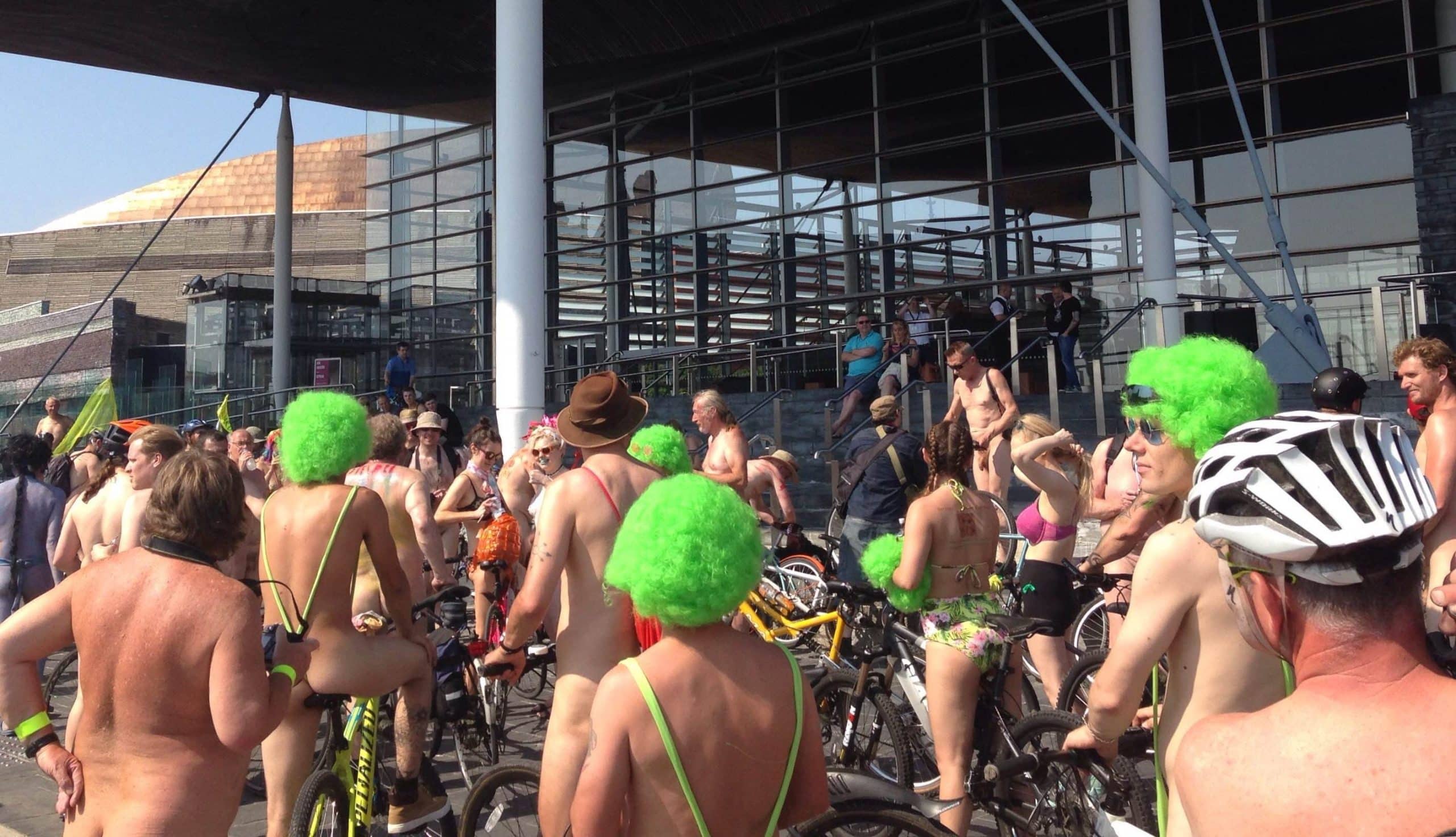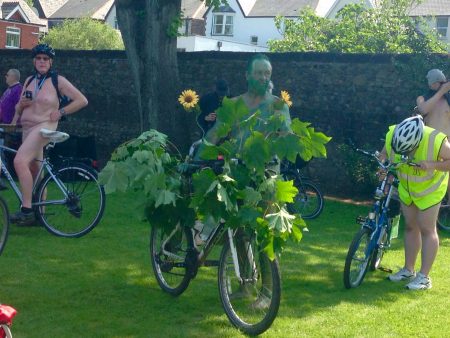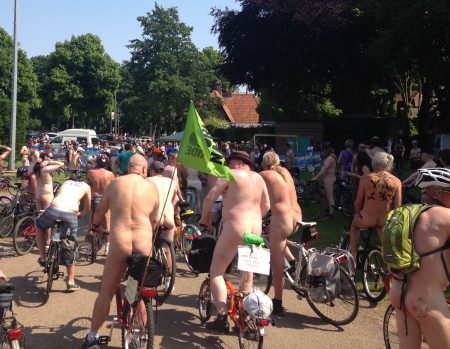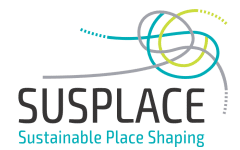
text and pictures by Lorena Axinte
For a city where cycling’s modal share is still modest[1], a group of almost 150 cyclists going around the main streets on a sunny Sunday afternoon might come as a surprise. The fact that most of them are completely naked is the added bonus.
Nonetheless, the world naked bike ride (WNBR) is nothing new in Cardiff where it was first organised in 2008 and attended by less than 40 enthusiasts[2], managing to grow more and more each year. This peaceful demonstration that has become popular in different parts of the world, as well as in most big cities around the UK, sparked my interest because of different reasons. First, besides being a keen cyclist willing to support any initiative that helps promoting safer streets for active travel, transportation is one of the focal points of my project called Sustainable City Regions (one of the 15 themes that form SUSPLACE). Looking at the two Welsh city regions (Cardiff Capital Region and Swansea City Region), my aim is to create an evidence base for place-based policies and interventions which can turn into pathways for creating a sustainable city region. Second, having moved to Cardiff only in April, I’ve been trying to attend as many events as possible so as to get a feel of the city and understand the overall context, thinking this is just as important as the articles, documents and policies I am studying.
Something that I understood from the very beginning was that along with numerous other bike initiatives and movements such as Cardiff Cycling Campaign, Cardiff Cycle City, Cycle Training Wales, Cardiff Cycle Chic, as well as Sustrans (a UK-wide charity enabling people to travel by foot, bike or public transport), the WNBR highlights important transportation issues. The overall aim is to raise awareness of the cyclists’ vulnerability on the road, demanding safer routes and a curbing in the number of cars especially in the city centre. At the same time, it represents a celebration of the human body and the individuality and power of each person.

The 2016 edition tried to create the usual carnival-like positive atmosphere, encouraging cyclists to make themselves heard through music, horns and whistles, as well as promote messages under different forms. Besides banners and flags saying ‘see us when we’re not naked’ or asking for ‘car free days’, people used body painting for statements such as ‘I’m not a crash test dummy’ or ‘my ass smells better than your gas’.
Although the event was widely promoted through different social media platforms and was authorized by the city council, as well as the South Wales Police, the majority of drivers and passers-by still looked astonished. Unlike regular critical masses though, the ride’s reception was much more positive and there was no conflict with other traffic participants who seemed happy to stop, take photos and wait for the bikers to pass.
Despite trying to be as inclusive as possible using the ‘as bare as you dare’ dress code, nudity might have been one of the major deterrents for many people. Probably the most common socio-economic profile of the attendees could be described as white, middle-aged, middle-class man, with clear underrepresentation of women and under 25s. Interestingly enough, some of the ones I got to talk to had driven from other nearby cities such as Newport, Bristol and even Southampton, not wanting to miss this year’s event but trying to avoid meeting any acquaintances at the same time. It’s hard to tell how many more people would have otherwise joined a regular cycling protest.
All in all, the 2016 WNBR was an unconventional event which helped one of the most disadvantaged categories of traffic participants become the centre of attention for at least two hours. Whether its success will only be short-lived remains to be seen. The numerous changes on the Welsh political scene (including a recently elected National Assembly, the establishment of Cardiff Capital Region and the agreement of a City Deal for the development of an integrated transport system at the regional level) might delay any actions from taking place. In addition, in the context of continuous budget cuts, improvement to cycling infrastructure might occupy the last in line, after the Metro[3] and the M4 relief road[4].
 Nonetheless, non-motorised travel has overtly been put on the political agenda through bills that cover the entire nation such as the Active Travel Act[5] and also local plans developed by Cardiff Council such as the Strategic Cycle Network Plan[6] (accompanied by a Cycle Design Guide[7]). While proud to have included sustainable development in its constitution as early as 1998, Wales is still struggling to reduce air pollution levels, high car-dependency patterns and unhealthy lifestyles – trends which affect Cardiff as well. And although it is widely agreed that cycling can improve all the aforementioned issues, it has also been demonstrated that well-designed infrastructure that is attractive and makes people feel safe remains the most effective way to encourage everyday active transport[8][9].
Nonetheless, non-motorised travel has overtly been put on the political agenda through bills that cover the entire nation such as the Active Travel Act[5] and also local plans developed by Cardiff Council such as the Strategic Cycle Network Plan[6] (accompanied by a Cycle Design Guide[7]). While proud to have included sustainable development in its constitution as early as 1998, Wales is still struggling to reduce air pollution levels, high car-dependency patterns and unhealthy lifestyles – trends which affect Cardiff as well. And although it is widely agreed that cycling can improve all the aforementioned issues, it has also been demonstrated that well-designed infrastructure that is attractive and makes people feel safe remains the most effective way to encourage everyday active transport[8][9].
[1] 5% of the population cycle daily according to Sustrans’ report Bike life Cardiff 2015 http://www.sustrans.org.uk/sites/default/files/bike_life_cardiff_2015.pdf
[2] WNBR Cardiff – World Naked Bike Ride http://wiki.worldnakedbikeride.org/wiki/Cardiff
[3] Welsh Government.(2016). Public transport – Metro. http://gov.wales/topics/transport/public/metro/?lang=en
[4] Welsh Government. (2016). M4 Corridor around Newport. http://gov.wales/topics/transport/roads/schemes/m4/corridor-around-newport/draft-orders/?lang=en
[5] Welsh Government. (2013). Active Travel (Wales) Act 2013. http://www.legislation.gov.uk/anaw/2013/7/pdfs/anaw_20130007_en.pdf
[6] Cardiff Council. (2011). Strategic Cycle Network Plan. http://www.keepingcardiffmoving.co.uk/uploads/documents/38/original/Cardiff_Strategic_Cycle_Network_Plan.pdf?1313418499
[7] Cardiff Council (2011). Cardiff Cycle Design Guide. http://www.keepingcardiffmoving.co.uk/uploads/documents/37/original/Design_Guide_FINAL.pdf?1319638020
[8] Hull, A., & O’Holleran, C. (2014). Bicycle infrastructure: can good design encourage cycling?. Urban Planning and Transport Research, 2(1), 369-406.
[9] Sustrans (2016). Fit for life. Independent research into the public health benefits of new walking and cycling routes. http://www.sustrans.org.uk/sites/default/files/images/files/Sustrans%20Fit%20for%20Life.pdf
